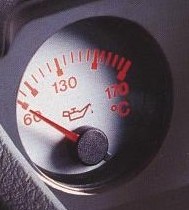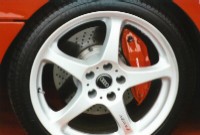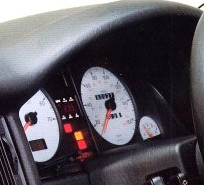| Warming
Up: As you drive the car whilst the engine warms up, you should
check that the idle speed is steady as you slow down and declutch on the approach
to traffic
lights etc.
If the car tries to stall during the warm up sequence,
then minor adjustments or repairs to the fairly complex
idle management system may be required. Possible candidates are vacuum hose leaks, a
sticky idle stabilser valve or a worn or badly adjusted throttle position
switch. Seek specialist knowledge if its not posted on the Tech Info
section of this site !
The car can exhibit unsteady idle when cold, hot,
when warming up or any combination thereof depending on the actual faults.
|
Suspension:
As you drive, ensure that the suspension and steering provide a positive
feel and that the ride isn't choppy or sloppy indicating worn shock
absorbers or bushes. Note that vehicles fitted with aftermarket
polyurethane bushes will provide zero comfort on bumpy roads as
they are designed primarily for the race track where compliance to optimal suspension
settings is more important than comfort.
At some point on the trip, embark on some low speed
loops or figure-8's on full steering lock, listening and feeling for
knocking. This generally indicates wear in the steering gear, balljoints,
bushes or CV joints.
Check also that the
steering does not pull to one side and there is no wheel vibration at low
or high speeds on the road. Could be as trivial as wheels off balance or
more serious with a bent alloy or worn out wheel bearing.
|
| The
Guages: Keep an eye on these whenever possible. The coolant
temperature should stay close to 90 degrees at all times. Too low,
and the thermostat is perhaps stuck open. Too high, and more serious faults
are possible. Listen for the radiator fan cutting in if the coolant temp
starts to climb in heavy traffic at low speed.
The oil pressure should be in the region of 4 bar when
the revs are above 2000 rpm, and between 1.5 and 2.0 bar when idling.
Oil temperature
should stay comfortably between the 90 and 130 degree marks unless the vehicle is driven at
very high
speed for prolonged periods on a hot day.

|
Performance:
Obviously I'm not going to tell you to floor a strangers car on the vague
notion of testing the turbo, but you should certainly satisfy yourself
that the acceleration of the car is up to scratch. But alas, the S2
doesn't have a boost guage so you might want to partake of some wise overtaking
manoeuvers to test the 'surge factor'. You should feel
strong acceleration when the engine speed is in excess of 2500-3000 rpm.
As you accelerate through the gears, you should keep an eye in the mirror for blue
or white smoke. If its blue it can indicate high piston or cylinder wear,
whilst white smoke is more often associated with excessive wear on the
turbocharger. Worn turbos often whine under duress also. Should you detect
a lack of power under throttle, or flat spots in the engine's range on
what is basically a tidy car it would be worth having a specialist
retrieve any fault codes from the cars ECU. Look out for more info on
fault codes in the Pet Projects section. These fault codes greatly assist
the diagnosis of faults in the engine and its breathing apparatus.
Also verify that the gearchange is positive and
smooth with no nasty grinding or whining noises from the transmission. The
6-speed is especially pleasing to shift. More positive than 5-cog.
|
| Brakes
Again: As the front brakes on the S2 are known to be
the car's weak point, you should check their performance at sufficient
speed to determine their effectiveness and pedal feel.
If the front brakes
are any way worn, it is common to feel vibration through the steering wheel
under hard braking. This will of course be exacerbated by incorrectly
balanced wheels.
An S2 fitted with standard brakes doesn't stop as
swiftly or as smoothly as most would like, so don't expect to be impressed by the
brakes unless they are of the upgraded aftermarket variety - such as the
monster conversion shown below.

Keep an eye on the Pet Projects area for a feature
on S2 brakes...
Cool the
engines: After the drive you'll want to keep the engine running
and have another quick look under the hood for leaks or listen for any
nasty noises. Be very wary of the radiator fan - it is thermostatically
controlled so don't be getting fingers, clothing or hair anywhere near the
fan or other moving parts.
You might detect the after-run cooling
system kick in. This prevents heat build up in the turbo bearings. At time
of writing I do not know a good way to test this, which is a pity, but
I'll work it out eventually !
On shutting off the engine, you should
test the brake pressure accumulator. It's function is to retain a decent
amount of brake servo assistance in a stall or emergency situation. With
the engine off, count the number of pedal pumps required to drain the
vacuum assistance. If more than 25, the system is in good shape. If more than
10-15 then some attention is required, but if its below 10 there is a
fairly major fault and should be repaired very soon.
|
Accessories
& Gizmos:
It is wise to check that all the car's many standard and optional accessories work - you can do this
on the road or later, but many are best checked for
effectiveness whilst stationary at the end of the test drive so as not to
distract.
Check the air conditioning for icy cold air AND toasty warm
air at both extremes of the temperature dial. Check the blower motor works
at all speed settings and don't forget to check the
recirculation system (REC switch). Engaging the REC mode, shuts off the
fresh air entering the system. You should be able to hear the motor moving
the flap(s) which control this airflow when you select and cancel the REC
switch. Air conditioning can certainly be expensive to fix, but it
can also be fairly easy to diagnose if you know how to identify main
faults and not get ripped off. Watch for upcoming air-conditioning
features here at S2 Central...
Another accessory that is tricky to test when the
weather is good, is the electrically heated door mirrors. Both are
activated with the rear screen demister. After a minute or two you
should be able to feel the warmth on the mirrors with your
fingertips.
Check the sunroof, electric windows, alarm, all the
lights, the headlamp washers, headlight adjusters, window wipers & washers
front & rear and any other gizmo fitted to the car. The ambient
temperature display should be on all the time, but faults are not
uncommon. Worst case reckon on approx 80 quid for a new display or more
likely 60 quid for the sender. Or both ? :( I'll try to figure a way to
test this trinket one day - Mine doesn't work yet !
One more thing -
try to establish that all the instrument backlighting works. Its not
rocket science to fix, just an arse having to remove the steering wheel
and instruments to change a two bit bulb.
Always ask the owner about any hidden switches for
an aftermarket alarm or immobiliser system. These can be a real pain if
you don't know where or how they are fitted.
|





